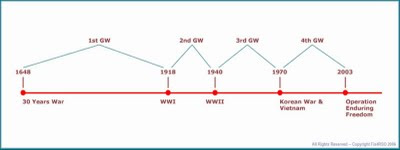Today's hot topic-Hybrid Warfare
- The basic analysis of generational warfare (GW) has been applied mainly to disruptive or transformative technologies and their affects on tactics and the operational level of warfare. However, the concept of “asymmetric” warfare is better applied at the operational and strategic level of warfare and is a fundamental change in the way warfare is conducted at not only the strategic, but ultimately the political level. Although asymmetric warfare is driven and enabled by technology, the more important differentiator is the psychology of the opposing sides and how each views the conflict being waged and the means and limits each side is willing to bring to the war.
- Strategically and operationally, future warfare will not be easily categorized into conventional, generational or asymmetric warfare, but will likely become some combination or “hybrid” conflict that will combine elements of conventional combat, terrorism and asymmetric warfare, all held together by a psychological warfare plan to drive tactics and operations.
- Even the technical dimension of generational warfare will lose its meaning against well-executed asymmetric warfare. Suicide car bombs can be just as effective as tanks and artillery at destroying a building. More importantly, future insurgent and non-state groups will have no compunction about using non-combatants as defenses against Western militaries reluctant to use massive firepower in the face of unbalanced media coverage. For better or worse, Western militaries are held to tighter rules of engagement, which their opponents either blithely ignore or actively circumvent to attack the will of Western societies. The fact that asymmetric opponents are willing to wage unlimited, no-quarter warfare has not been completely understood by Western militaries and is really incomprehensible to modern Western society. Moreover, asymmetric warfare will also bring asymmetric measures of victory, usually to the advantage of the weaker side. Just as powers that wage counter-insurgencies are considered to be losing if they are not winning, in the future, non-state actors and terrorist groups waging asymmetric warfare can “win” a war by simply not being completely annihilated by their opponent.
- The U.S. military is still coming to grips with the issues of “generational” versus “asymmetric” warfare and has only begun to understand the “hybrid” wars that it is likely to face in the 21st century. As information technology and sophisticated weaponry become more ubiquitous, the technology advantage that Western armies have long enjoyed over potential adversaries will continue to dissolve. Once again, issues of training, moral, willpower and even simple numbers will become decisive factors on the battlefield. The issues of generational warfare involving weapons and tactics and conventional versus asymmetrical warfare must merge into developing a doctrine to wage some combination of conventional, information, and psychological hybrid warfare to attack not only an opponent’s military but their entire society and will as the U.S. military seeks some weakness of our opponent, whether that opponent is a Hezbollah fighter or a Chinese tank commander.
- This debate is likely to become part of the ongoing 2010 Quadrennial Defense Review. Should the U.S. military be prepared to wage 4GW against the Chinese or North Koreans or asymmetric warfare against Al Qaeda? How do we prepare to fight both? This will not be an easy question to answer, as special operations units are very different from armored battalions. More importantly, can the U.S. military reorganize, train, and prepare as the Israelis did to fight an enemy that knows how to use asymmetric means to negate our technology advantage and use information technology and “media warfare” to win a strategic victory even as they are defeated on the battlefield. The changes of generational warfare are no longer as relevant as they once were as the lines between conventional and asymmetric warfare become increasingly blurred.

Comments